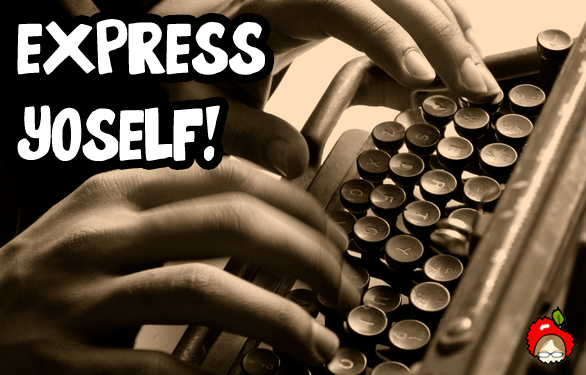During my day job of substitute teaching, I’ve noticed a wonderful trend: classrooms are getting progressively geekier. Teachers can use geek culture to connect with their kids, but they’ve also been using it to help kids connect to the world.
For example…
Creative Tables
You know how in elementary school, desks are usually clustered into small “tables” for group work? The tables are usually distinguished somehow, either numbered or given a color or something of the sort.
Well, teachers have started going the extra mile and separating their kids into Gryffindor, Ravenclaw, Hufflepuff, and Slytherin.

The first time I saw this I thought it was clever. The teacher had printed out the house crests and hung them over each table, and my inner child just danced when I called Ravenclaw to line up first for PE.
The second time, though, I was actually a little appalled: I was in for a teacher’s assistant (meaning the teacher herself was present) and within about ten seconds of being in the classroom it was apparent the teacher had actually Sorted the students. Gryffindor was full of popular kids, Slytherin was constantly trying to get out of work, Ravenclaw had all five hands constantly in the air, that sort of thing. It boggled my mind. Usually teachers make an effort to avoid troublesome combinations.
Then they started working in pairs, and she told all the Gryffindors to pair up with a Slytherin, and all the Hufflepuffs to find a Ravenclaw.
In this case, I don’t know how the seating arrangement worked out, since I was only there for a day. But that’s a great way of getting kids to work with someone they usually wouldn’t — while still giving them the agency to choose a partner.

I’ve seen other creative uses of table-naming, too: art classes where tables are named after famous painters, for example, or classrooms where they use book titles.
Computer Clubs
Computer clubs are nothing new, but technology has gotten far more accessible over the past decade. The wandering laptop cart I grew up with has been upgraded to a tablet cart, for one, and whiteboards are rarely used in favor of Smart Boards.
(Digression: I was in high school when Smart Boards came out. Our teachers made a video in which they came alive, HAL-style, and took over the school. There were lots of ZAP noises and teachers dying dramatic deaths. This was presented to the entire school, and is evidence that the dorkiness of teachers isn’t entirely new.)
The computer clubs I’ve seen lately have access to some awesome toys, including things like the Raspberry Pi and 3D printers. Kids now have access to more than just sandbox coding and the internet: they can build things completely on their own.

With the advent of the mini-computer like the Raspberry Pi, kids can learn to build their own computer and have complete freedom when it comes to coding. The club I saw was building the computer as a group and letting the kids each have their own “hard drive” on a USB stick, which was an amazing idea.
And the 3D printer clubs are half-programming, half-art-class. I got the chance to see some of the things a group of middle-schoolers cooked up, since a library I was working in had them on display. The figurines included a dragon, a giant heart, a bunch of complicated bits that someone eagerly explained would make up a Transformer (no idea if it actually worked), a Pokeball, and a trophy.
Awesome Book Nooks
Classroom libraries seem to have become a work of art. I’m not sure if it was the same back when I was in elementary school, but I’ve seen some amazingly creative ones.
My personal favorite (so far) was made to look like the TARDIS: three bookshelves in a U shape, with construction-paper police box siding taped to their backs. Above, in a banner, the teacher had written out the quote “In all of time and space, I’ve never met anyone who wasn’t important.”
Inside the U was a pile of pillows and beanbags and blankets, so the kids could read all over the classroom during book time.
Other favorites: The three-shelf classroom library based off the original Pokemon starters, with easy books under a plushie Bulbasaur and hard books under Charmander. Or a Hogwarts-themed corner: similarly-designed to the TARDIS, but with a castle, and little wands you had to take when you “checked out” a book.
Or the Redbox-based corner (“Bookbox”). Or the one just covered in Minecraft figurines for no reason other than the kids liked it– and I think the teacher wanted an excuse to have a ton of Minecraft toys.

I’ll admit it: it still takes some mental re-framing to think of myself as a teacher whenever I enter a classroom. Stuff like this doesn’t help: I would be perfectly happy to sink down in the TARDIS book corner and read all day.
 Alex Penland is currently enjoying a longtime addiction to stories, which she feeds through books, tabletop RPGs, and an excessive collection of video games. She’s currently seeking to publish a novel about a bookshop that gets abducted by aliens, loves to crochet, and blogs about it all over at https://alexpenland.wordpress.com/. You can follow her on Twitter @AlexPenname, where she spends two hours every Saturday livetweeting whatever books strike her fancy.
Alex Penland is currently enjoying a longtime addiction to stories, which she feeds through books, tabletop RPGs, and an excessive collection of video games. She’s currently seeking to publish a novel about a bookshop that gets abducted by aliens, loves to crochet, and blogs about it all over at https://alexpenland.wordpress.com/. You can follow her on Twitter @AlexPenname, where she spends two hours every Saturday livetweeting whatever books strike her fancy.















Recent Comments